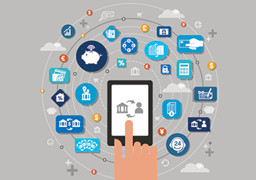




 |
 |
 |
|||
 |
 |
 |
 |
 | |
 |
 |
 | |


| 미디어 브리핑스 | 내서재담기 |


  |
 |  |
디지털 혁명이 전 세계의 모든 산업구조를 재편하고 있다. 금융과 은행도 그 흐름에서 예외가 아니다. 오히려 더 극심한 변화에 직면해 있다. 금융 산업은 어떻게 바뀔 것이며, 무엇이 승자와 패자를 결정할 것인가? 우리는 그 변화에 어떻게 대비해야 하는가?
그리 오래되지 않은 과거만 해도 미국의 도시나 근교 지역을 지나면서 비디오 대여점, 서점, 음반 가게를 보지 않고는 중심부를 통과할 수 없었다. 한때 단단한 듯 보였던 이 사업들은 넷플릭스, 아마존, 판도라Pandora 등의 온라인 업체에 의해 사라져버렸다. 이 상점들이 빠져나간 장소에 무엇이 들어섰는가? 바로 은행 지점이다. 미국에 9만 4,752개의 은행 지점이 있고 미국 인구가 3억 1,890만 명이라는 걸 생각하면, 약 3,366명당 한 곳의 지점이 있는 셈이다.
그러나 10년 이내에 혹은 그보다도 더 빨리 이 지점들 중 80%는 사라질 전망이다. 책, 음악, 영화, 그리고 모든 소매점들처럼 은행도 곧 사라질 운명이며, 이는 실제 세계에서의 거래에서 스마트폰을 이용한 이체로 바뀌어 가고 있기 때문이다.
여기서 핵심적으로 깨달아야 할 점은, 금융 거래는 더 이상 달러를 통해 이뤄지지 않는다는 점이다. ‘비트bit’로 거래된다. 급여 예치, 현금 인출, 대출금 납입에는 더 이상 은행 창구 너머로 현금 뭉치를 건네는 일이 필요하지 않다. 대신에 정보의 비트가 교환될 뿐이며, 이 비트들은 과거보다 쉽게 교환될 수 있다. 창구 직원에게 서류를 제출하는 것보다 모바일 앱을 통해 원격 시설에 있는 서버에 연결하는 편이 실제로 훨씬 쉽다.
이 비트들은 또한 앱을 통하면 훨씬 싸게 전송될 수 있다. 2,900개의 지점을 보유한 ‘PNC 파이낸셜 서비스 그룹’의 회장 윌리엄 뎀차크William Demchak는 <월스트리트저널>에 기고한 글에서, 고객이 창구 직원에게 가는 대신 스마트폰을 이용해 입금을 처리할 때마다 은행은 3.88달러를 절약하는 셈이라고 밝힌 바 있다. 매년 한 은행당 거래가 수백만 건에 달한다는 점을 고려하면 이로 인해 발생되는 수익의 규모를 짐작할 수 있다.
미국 30대 은행들이 지점 유지와 직원 고용 비용으로 매년 500억 달러를 소비하고 있지만, 투자 자문 기업인 알릭스파트너스AlixPartners의 연구에 따르면 미국 은행 거래의 14%만이 지점에서 진행되며, 나머지는 인터넷 뱅킹과 모바일 뱅킹을 통해 이뤄진다고 한다. 이는 미국 은행 산업이 더 이상 거의 10만 개에 육박하는 지점을 필요로 하지도 않고 그럴 여유도 없다는 것을 의미한다. 경제뉴스 전문방송인 CNBC에 따르면, 은행은 매년 수천 개의 지점을 신규 증설하고 있지만, 과거 2년간은 미국에서만 약 3,000개 이상의 지점을 폐쇄했다고 한다.
보다 중요한 점은, 오직 가상으로만 고객의 금융 거래를 지원하는 은행(전혀 지점을 두지 않은 곳)이 경쟁우위를 누리고 있다는 것이다. 비용이 높은 부동산과 고객을 직접 대면하는 직원을 갖지 않은 이들의 비용 구조는 기존 은행에 비해 90%나 낮다.
이런 이유로 신생 기업들이 벤처 자본을 끌어들이고 있다. 은행 산업 전문가인 크리스 스키너Chris Skinner에 따르면, 금융finance과 기술technology의 결합이라는 의미로 소위 ‘핀테크Fintech’라 불리는 이 기업들이 벤처 투자로 받은 자금은 2012년에 10억 달러 이하였지만, 2013년에 40억 달러, 2014년에는 무려 132억 달러로 늘어났다.
<이머징 마켓 리뷰>가 왜 그렇게 많은 벤처 자금이 투자되는지를 묻자 스키너는 다음과 같이 답했다. “투자자들이 수익을 낼 수 있기 때문이다. 2014년에 10억 달러 이상의 가치를 지녔다고 평가받은 핀테크 스타트업 기업이 렌딩 클럽Lending Club, 스트라이프Stripe, 펀딩 서클Funding Circle, 스퀘어Square를 비롯해 36곳이나 됐다. 2013년만 해도 12곳에 불과했다.
이 기업들은 크라우드펀딩, 대출, 새로운 결제 시스템을 위한 P2P 환경을 창출하는 일에 모바일 인터넷을 이용하고 있다. 실제로 조파Zopa와 트랜스퍼와이즈TransferWise 등 핀테크 기업의 1/3은 P2P 연결성에 중점을 두고 있고, 클라르나Klarna와 트랙스페이Traxpay 등 다른 1/3은 결제 시스템에 집중하고 있다. 이러한 기업들은 정말로 게임을 변화시키고 있으며, 그 결과 은행은 돈을 잃고 말 것이다.
과연 얼마나 많은 돈을 잃게 된다는 말인가?
골드만삭스의 보고서에 의하면, 고객이 은행보다 P2P대출자로부터 빌리는 것을 선호함에 따라, 은행은 2020년 말경에는 신용 분야에서만 전체 시장의 약 1/5에 해당하는 100억 달러 이상의 수익을 잃게 될 것이라고 한다.
그렇다면 앞으로 은행의 미래는 어떻게 될 것인가?
첫째, 이전의 디지털 변혁 과정에서처럼, 기존 은행들이 이런 혁명이 발생하지 않을 것이라 여긴다면 그들은 살아남지 못할 것이다.
전통적인 은행은 디지털이 가져올 미래의 생존을 위해서는 변화에 대한 자신들의 저항을 극복해야 할 필요가 있다. 스키너에 따르면 대개의 많은 은행 경영진은 디지털을 콜센터나 은행 지점 같은, 단지 또 다른 채널의 일종으로 인식할 뿐이라고 한다. 그들은 그런 생각에서 벗어나 전자 창구가 고객과의 소통을 이루는 기초라는 점을 깨달아야 한다.
둘째, 현재 미국의 어느 거리 모퉁이에나 상존하고 있는 은행 지점들은 곧 서점이나 레코드 가게처럼 보기 힘들어질 것이다.
스키너는 자신의 책 <<디지털뱅크, 은행의 종말을 고하다Digital Bank>>에서 이런 현상이 이미 유럽에서 발생하고 있다고 얘기했는데, 지난 4년간 지점 수가 덴마크에서 33%, 네덜란드에서 25%, 스페인에서 17%, 독일에서 8%, 영국에서 5%, 프랑스에서 3% 줄어들었다. 또 이 책은 투자 관련 뉴스를 제공하는 <모틀리 풀>의 기사를 인용해, 미국 은행 지점들에서의 거래량이 지난 16년 동안 매년 4%씩 줄어들고 있다는 점도 밝혔다. 그런데 주변의 서점이나 레코드 가게가 없어졌을 때와는 다르게 사람들은 누구도 은행 지점의 폐쇄에 대해 불평하지 않을 것이다.
<<미래와의 대화Communicating With the Future>>의 저자인 토머스 프레이Thomas Frey에 따르면, 최근 비아콤 미디어가 1만 명의 미국인을 대상으로 여론조사를 한 결과, 조사 대상자의 71%는 은행원과 상담하느니 차라리 그 시간에 치과에나 가겠다고 답했다. 스키너는 현재 미국 은행 지점 중 80%는 문을 닫을 것으로 예측한다. 이들은 셀프 서비스가 가능한 위성 방송으로 대체될 것이며, 고객들은 ATM 기기를 사용하거나 원격 영상을 통해 상담자와 접촉할 수 있다. 나머지 20%의 지점은 애플의 지니어스바Genius Bars 모델을 본뜬 보다 세련된 점포로 변해, 고객이 실제 금융을 잘 이해하는 사람으로부터 직접 은행 서비스를 받을 수 있게 될 것이다.
셋째, 현재 디지털 금융 거래와 대출의 이점을 활용하고 있는 기업은 소수에 불과하나, 그 수는 빠르게 늘어날 것이다.
현재 이 분야의 리더라 할 수 있는 기업은 알리바바Alibaba, 텐센트TenCent, 폴란드의 엠뱅크mBank, 호주의 커먼웰스 뱅크Commonwealth Bank, 인도의 ICICI 뱅크 정도다. 그러나 스키너는 이런 기업들조차 진정 디지털화가 되지 않았다고 주장한다. 즉 그들은 아직 고객에게 일대일로 개인화된 디지털 서비스를 제공하는 인터넷 기반의 핵심 시스템을 갖추고 있지 않다. 스키너는 인터뷰를 통해 다음과 같이 말했다. “개인화란 결국 각 개인이 다음에 무엇을 할지 쉽게 결정하기 위해 지난번에 한 일을 기억하는 일이다. 디지털 중개인은 많은 데이터를 얻을수록 이 개인화가 더 쉬워진다. 에어비앤비, 페이스북, 구글은 당신이 어디에 머물렀는지, 지난번에 어떤 글을 올렸고 무엇을 검색했는지 알고 있기 때문에 당신이 그들의 서비스에 접속할 때마다 쉽게 개인화에 근거해 프로세스를 단순화할 수 있는 것이다. 바로 이것이 은행과 보험업자가 해야 할 일이다. 개인화를 통해 연결하고, 단순화하고, 반복하기. 이것이 디지털 시대에 고객을 끌어들이고 유지하는 기본이다.
스키너는 자신의 저서에서 광범위한 고객의 데이터를 분석하여 고객이 현재 필요로 하는 은행 서비스가 무엇인지를 파악하는 것이 목적이 되어야 한다고 역설했다. 고객들이 이 서비스에 사전 동의만 한다면, 디지털 은행은 소셜 미디어에 고객들이 올리는 글을 모니터링하고 개인 메시지를 통해 응대할 수 있다. 만약 고객이 트위터에 값비싼 고급 승용차를 살 계획이라고 올리면, 디지털 은행의 메시지는 차량 구입을 위한 고객의 신용 상태와 재정 상담을 제공할 수 있다. 페이스북에 이제 막 휴가차 로마에 도착했다는 포스트를 올리면 디지털 은행은 환율과 호텔 근처의 ATM 기기 지도를 함께 전송해 줄 수 있을 것이다.
넷째, 지상 통신 기반시설의 부족 탓에 개발도상국에서 모바일 폰 기술이 선진국보다 급속히 퍼졌던 것처럼, 디지털 뱅킹도 미국에서보다 중국, 동유럽, 아프리카에서 훨씬 더 빨리 퍼질 것이다.
과거 은행은 수익 잠재력이 낮은 가난한 지역에서 지점을 개설하는 것에 신경 쓰지 않았다. 하지만 수백만 명이 스마트폰을 통해 전 세계 어디든 연결되는 지금의 세상에서는, 누구나 다른 사람들에게 팔고 빌리고 소통하는 일이 가능하다.
이에 대해 스키너는 이렇게 설명한다.
“에티오피아의 염소 농장주는 염소 가죽 등을 한국의 소비자에게 QQ(중국 최대의 인터넷 기업 텐센트가 운영하는 메신저 서비스. 위챗도 텐센트가 운영하는 메신저 서비스다), 위챗Wechat, 알리페이Alipay, 문자메시지 결제 등을 통해 판매할 수 있게 될 것이다. 이는 놀랍도록 새로운 세계이자 새로운 개념이다. 지구상의 모든 사람들이 어디서나 누구에게나 무엇이든 사고 팔 수 있다.”
다섯째, 산업 혁신의 초기 단계에서는 어떤 기업이 10년 후 성공할지 예측할 수 없으나, 현재 시점에서 특별히 주목되는 몇몇 기업들이 있다. 이체 결제수단 가운데는 스퀘어, 클라르나, 스트라이프, 커런시 클라우드Currency Cloud, 트랜스퍼와이즈가 이런 기업에 해당된다. 대출 서비스에서 주목받는 리딩 기업에는 렌딩 클럽, 프로스퍼Prosper, 캐비지Kabbage, 조파, 펀딩 서클 등이 있다. 벤처 투자 회사로서는 디지털 뱅킹 외에 대출과 결제 서비스에 공격적으로 투자하는 것이 큰 의미가 없을 전망인데, 벤처 투자사들이 2014년 핀테크 스타트업 기업들에 투자한 총 132억 달러 중 2/3에 해당하는 금액이 디지털 뱅킹 분야에 몰렸다.
* *
References List :
1. The Wall Street Journal, March 31, 2013, “After Years of Growth, Banks Are Pruning Their Branches,” by Robin Sidel. ⓒ 2013 Dow Jones & Company, Inc. All rights reserved.
http://www.wsj.com/articles/SB10001424127887323699704578326894146325274
2. CNBC News, November 2014, “Bank Branches Slowly Fading Away in Neighborhoods,” by Jeff Cox. ⓒ 2014 CNBC LLC. All rights reserved.
http://www.cnbc.com/2014/11/13/bank-branches-slowly-fading-away-in-neighborhoods.html
3. The Finanser, September 1, 2015, “The State of Digital, Fintech and the Future Bank,” by Chris Skinner. ⓒ 2015 Financial Services Club. All rights reserved.
http://thefinanser.co.uk/fsclub/2015/09/the-state-of-digital-fintech-and-the-future-bank.html
4. Ibid.
5. The Finanser, May 13, 2015, “Goldman Sachs Estimate 20% of Bank Lending Will Move to Alternative Finance ($12bn of Profits Lost),” by Chris Skinner. ⓒ 2015 Financial Services Club. All rights reserved.
http://thefinanser.co.uk/fsclub/2015/05/goldman-sachs-estimate-20-of-bank-lending-will-move-to-alternative-finance-12bn-of-profits-lost.html
6. Digital Bank: Strategies to Launch or Become a Digital Bank by Chris Skinner is published by Marshall Cavendish Business, an Imprint of Marshall Cavendish International. ⓒ 2014 Chris Skinner. All rights reserved.
7. Stock Gumshoe, June 19, 2013, “‘Big Banking’s $20.8 Trillion Secret’ Pick from David Gardner,” by Travis Johnson. ⓒ 2013 Stock Gumshoe, Inc. All rights reserved.
http://www.stockgumshoe.com/reviews/motley-fool-rule-breakers/big-bankings-20-8-trillion-secret-pick-from-david-gardner/
8. Communicating with the Future: How Re-engineering Intentions Will Alter the Master Code of Our Future by Thomas Frey is published by DaVinci Institute. ⓒ 2011 Thomas J. Frey. All rights reserved.
9. The Finanser, September 1, 2015, “The State of Digital, Fintech and the Future Bank,” by Chris Skinner. ⓒ 2015 Financial Services Club. All rights reserved.
http://thefinanser.co.uk/fsclub/2015/09/the-state-of-digital-fintech-and-the-future-bank.html
10. Communicating with the Future: How Re-engineering Intentions Will Alter the Master Code of Our Future by Thomas Frey is published by DaVinci Institute. ⓒ 2011 Thomas J. Frey. All rights reserved.
 |  |
The Future of Banking
It wasn’t long ago that it would have been nearly impossible to drive down a major street in any American city, town, or suburb without passing several video stores, bookstores, and music stores. Today, nearly all of those bricks-and-mortar businesses are gone, having been obliterated by online disrupters like Netflix, Amazon, and Pandora.
What has taken the place of all that vacant real estate? Bank branches. There are now 94,752 bank branches in the United States, and based on the U.S. population of 318.9 million, there is a bank branch for every 3,366 people.
However, within ten years - and perhaps even sooner - 80 percent of those branches will disappear.
That’s because - just like books, music, movies, and retail of all kinds - bricks-and-mortar banking is about to be vaporized, transformed from a transaction performed in the physical world to one that is accomplished with a swipe on a smartphone.
The crucial point to realize is that financial transactions are no longer about dollars. They’re about bits.
Depositing a paycheck in a savings account, withdrawing money from a checking account, making a mortgage payment, or paying off a business loan no longer requires pushing piles of cash across a counter. Instead, bits of information are exchanged, and those bits can be swapped just as easily - in fact, much easier - when a customer uses a mobile app on a smartphone to connect to a server in a remote facility, versus sliding pieces of paper across a teller’s window.
Those bits can also be transmitted a lot cheaper over the app: In a Wall Street Journal article, William Demchak, president of PNC Financial Services Group, which has 2,900 bank branches, revealed that every time a PNC customer deposits a check by taking a picture on her smartphone instead of going to a teller, the bank saves $3.88.1 Multiply that by millions of transactions per bank per year, and the size of the opportunity becomes clear.
Despite the fact that the thirty largest U.S. banks spend $50 billion per year to keep their branches open and fully staffed, according to research by AlixPartners only 14 percent of U.S. banking transactions are now conducted at branches, while the rest are completed through Internet banking or mobile banking.
What this means is that the American banking industry no longer needs - and certainly cannot afford - nearly 100,000 branches. Over the past two years, according to CNBC.com, despite thousands of new branch openings per year, banks have closed nearly 3,000 more branches in the U.S. than they have opened.2
More importantly, it also means that business models that are based on serving banking customers virtually (with no branches at all) enjoy a competitive advantage. Without the high overhead costs of real estate and personnel to meet customers in person, their cost structure is 90 percent less than established banks.
For that reason, upstarts are attracting a growing amount of venture capital. Such firms - called Fintech businesses, because they merge finance and technology - received $13.2 billion in VC investments in 2014, up from $4 billion in 2013, and less than $1 billion in 2012, according to banking industry expert Chris Skinner.3
Asked by Emerging Markets Review why VCs would invest so much capital, Skinner replied, “Because they can see the returns. In 2014, there were 36 new Fintech startups like Lending Club, Stripe, Funding Circle, and Square, with over a billion dollar valuations. The year before, there were only twelve, and next year, there will probably be over 100. These new companies are using the mobile Internet to create new peer-to-peer connections for crowdfunding and lending and new payments systems. . . . In fact, a third of the Fintech firms are focused upon P2P value connections like Zopa and TransferWise, while a third are focused upon payments like Klarna and Traxpay. These firms are really changing the game, and the result is that banks will lose money.”4
How much money?
According to a Goldman Sachs report, banks are expected to lose more than $10 billion of profitability, or roughly one-fifth of the total market, in the credit line of business alone by the end of the decade, as customers opt to borrow from peer-to-peer lenders rather than banks.5
What can you expect as this trend unfolds?
First, just as in previous digital disruptions, established businesses will not survive if they pretend the revolution isn’t happening.
Traditional banks will need to overcome their resistance to change in order to survive the reality of the digital future. According to Skinner, too many bank executives consider digital just another channel, like call centers, Internet channels, bank branches, and so on. Instead, they have to realize that a single electronic channel is the foundation for all of the ways in which it communicates with customers.
Second, the ubiquitous bank branch, which now seems to loom over every street corner in the U.S., will soon become as scarce as a bookstore or record shop.
According to Skinner’s book, Digital Bank: Strategies to Launch or Become a Digital Bank, it’s already happening in Europe, where over the past four years the number of branches has fallen by 33 percent in Denmark, 25 percent in the Netherlands, 17 percent in Spain, 8 percent in Germany, 5 percent in the UK, and 3 percent in France.6 In his book, Skinner quotes a Motley Fool article that reports that traffic in U.S. bank branches has been going down by 4 percent per year over the past sixteen years.7 And, unlike the neighborhood bookstore or record shop, no one is going to complain about the closing of a bank branch. According to Thomas Frey, author of Communicating With the Future, a recent Viacom Media poll of 10,000 Americans found that 71 percent would rather go to the dentist instead of talking to a banker.8 Skinner predicts that 80 percent of today’s U.S. bank branches will close. They will be replaced by self-service satellite stations, where customers can use ATMs or connect to a human advisor via a remote video terminal. The other 20 percent of branches will be turned into sleek stores modeled after Apple Stores with Genius Bars, where customers can get in-person banking advice from people who really understand finance.
Third, only a few businesses are currently set up to reap the benefits of digital banking and lending, but this number will rapidly increase.
The current leaders include Alibaba, TenCent, mBank in Poland, Commonwealth Bank of Australia, and ICICI Bank in India. But even these businesses, according to Skinner, are not what he considers truly digital - that is, they still do not have the Internet-enabled core systems that are enterprise-wide and can provide a single view of the customer that allows them to provide the one-to-one personalized digital service they have come to expect.
According to the interview with Skinner, “Personalization is all about making sure you remember what the individual did last time to make it easier for them to do the next time and, for the data intermediary, that’s easy as they’ve got the data.9 Airbnb, Facebook, [or] Google know where you stayed, what you posted or searched for last time, and therefore they make it easier and easier each time you touch their service by simplifying that process on a personalized basis. That’s what banks and insurers need to do: Connect, simplify, and repeat, by making it personal. These are the basics of attracting and retaining the customer in the digital age.” In his book, Skinner elaborates that the goal is to use exabytes of customer data to identify what banking services customers may need in real time.10 As long as customers opt-in to the service, a digital bank could monitor their posts on social media and respond with private messages. If a customer Tweets that he is shopping for an expensive new luxury car, it can remind him that his credit score and the balance in his savings account advise against it. If a customer posts on Facebook or Square that she has just landed in Rome on a vacation, the digital bank can send a message detailing its exchange rate, along with a map of the closest ATMs to her hotel.
Fourth, just as mobile phone technology penetrated developing economies more rapidly because they lacked the landline infrastructure that slowed adoption in the developed world, digital banking will be embraced even more swiftly in China, Eastern Europe, and Africa than it will in the U.S.
In the past, banks didn’t bother to build branches in impoverished areas where the potential for profit was low. But now that billions of people are connected to each around the world via smartphones, everyone will be able to communicate - and sell to, or borrow from - everyone else.
As Skinner puts it, “Goat farmers in Ethiopia will be able to sell goat products - leather hides or crafts made from goat hide - to Korean buyers via QQ pages, Wechat photos, text-messaged payments, and Alipay logistics. That is an amazing new world and amazing new concept. Everyone on this planet can buy and sell anything with anyone, anywhere.”
Fifth, as in the early stages of any industry disruption, it is too early to predict which new businesses will triumph in ten years, but a few companies seem particularly promising at this point.
Among them are Square, Klarna, Stripe, Currency Cloud, and TransferWise in transferring payments. In lending, the preliminary leaders are Lending Club, Prosper, Kabbage, Zopa, and Funding Circle. It is worth noting that venture capital firms are pursuing lending and payments investments more aggressively than any other aspect of digital banking, representing two-thirds of the $13.2 billion that they invested in Fintech startups in 2014.
References
1. The Wall Street Journal, March 31, 2013, “After Years of Growth, Banks Are Pruning Their Branches,” by Robin Sidel. ⓒ 2013 Dow Jones & Company, Inc. All rights reserved.
http://www.wsj.com/articles/SB10001424127887323699704578326894146325274
2. CNBC News, November 2014, “Bank Branches Slowly Fading Away in Neighborhoods,” by Jeff Cox. ⓒ 2014 CNBC LLC. All rights reserved
http://www.cnbc.com/2014/11/13/bank-branches-slowly-fading-away-in-neighborhoods.html
3. The Finanser, September 1, 2015, “The State of Digital, Fintech and the Future Bank,” by Chris Skinner. ⓒ 2015 Financial Services Club. All rights reserved.
http://thefinanser.co.uk/fsclub/2015/09/the-state-of-digital-fintech-and-the-future-bank.html
4. Ibid.
5. The Finanser, May 13, 2015, “Goldman Sachs Estimate 20% of Bank Lending Will Move to Alternative Finance ($12bn of Profits Lost),” by Chris Skinner. ⓒ 2015 Financial Services Club. All rights reserved.
6. Digital Bank: Strategies to Launch or Become a Digital Bank by Chris Skinner is published by Marshall Cavendish Business, an Imprint of Marshall Cavendish International. ⓒ 2014 Chris Skinner. All rights reserved.
7. Stock Gumshoe, June 19, 2013, “‘Big Banking’s $20.8 Trillion Secret’ Pick from David Gardner,” by Travis Johnson. ⓒ 2013 Stock Gumshoe, Inc. All rights reserved.
8. Communicating with the Future: How Re-engineering Intentions Will Alter the Master Code of Our Future by Thomas Frey is published by DaVinci Institute. ⓒ 2011 Thomas J. Frey. All rights reserved.
9. The Finanser, September 1, 2015, “The State of Digital, Fintech and the Future Bank,” by Chris Skinner. ⓒ 2015 Financial Services Club. All rights reserved.
http://thefinanser.co.uk/fsclub/2015/09/the-state-of-digital-fintech-and-the-future-bank.html
10. Communicating with the Future: How Re-engineering Intentions Will Alter the Master Code of Our Future by Thomas Frey is published by DaVinci Institute. ⓒ 2011 Thomas J. Frey. All rights reserved.
